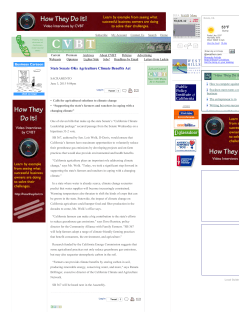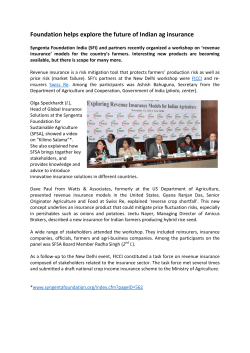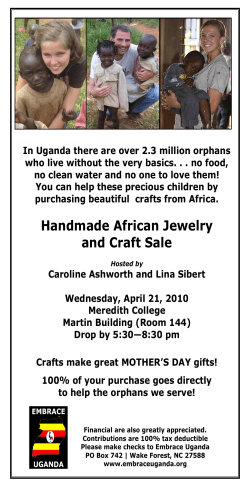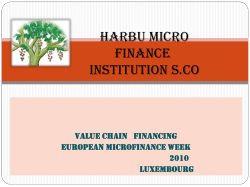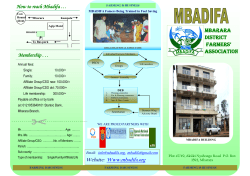
Anna Snidera,e*, Vincent Canwatb, Nashon Mogonchic
U N IVE R SITY O F C O PE NHAG EN *Correspondence to [email protected] Farmers’ Organizations: Building Social Capital for the Conservation of Natural Resources in Uganda Table 1 Positive and negative examples of social captial in SILC groups. Anna Snidera,e*, Vincent Canwatb, Nashon Mogonchic, Nawa Malumod, Andreas de Neergaardb, Nicole Sibeleta,e aCIRAD UMR Innovation, 34398 Montpellier France, bUniversity of Copenhagen, Denmark, cEdgerton University, Kenya, dMakerere University, Uganda eCATIE, IDEA Turrialba 30501; Costa Rica Relations of trust Reciprocity and exchanges Common rules, norms and sanctions Connectedness in networks and groups Transparency builds trust 95% repayment rate on loans Groups collectively develop terms of loans Sanctions against those who break the rules Members enjoy “the spirit of teamwork” Groups donate to community Groups create horizontal connections Discrimination against new members Groups create few vertical connections Justification for the Study Social capital, defined as trust in others, social networks and norms of reciprocity, is essential to foster the collective action necessary to conserve natural resources1. Farmers’ organizations can build social capital within groups (bonding) or among groups (bridging). Four features are important to consider regarding building social capital within organizations: relations of trust; reciprocity and exchanges; common rules, norms and sanctions; and connectedness in networks and groups2. Savings and Internal Lending Communities (SILCs) in the Nnindye parish of Uganda consist of a microlending component and a collectively managed banana plot. We looked for evidence that NGO-supported SILC schemes are building the important features of social capital which could then facilitate the sustainable management of community natural resources. Distrust is a barrier to Men receive more loans and participation. more plant material than Some women must sneak out women. of house to attend meetings or leave the group if they become “too empowered.” Can Savings and Internal Lending Communities (SILCs) build social capital which can then be used to collectively manage natural resources? Sanctions applied inconsistently Figure 1 A typology of social capital and the trajectories of social capital in Nnindye SILC groups. Adapted from Flora and Flora4. Bridging Clientelism Progressive Participation Bonding Social Capital in Nnindye without influence of SILC groups Results and Discussion There is a high density of farmers’ organizations in the Nnindye parish with several organizations in each village. Seventy percent of the members are women. All organizations observed were either self-initiated and externally supported or externally initiated and externally supported. Organizations without external support quickly dissolve. Extreme Individualism Distrust within the community (low social capital) prohibits farmers from participating in organizations. It is also a threat to the sustainable management of common resources, as corruption causes exploitation of resources. SILC groups are influencing social capital within the group (See Table 1) and bringing members together to collectively manage a banana plot. Bridging social capital (outgroup relations) is still lacking, causing strong personal boundaries and inhibiting new members (See Figure 1). The paradox of high densities of collective organizations with low levels of trust seems to contradict Putnam’s proxy of using membership in voluntary organizations as measure of social capital3. However we maintain that the density of voluntary farmers’ organizations is artificially high due to external support and not an accurate proxy for the social capital in this area. Despite the challenge of extreme individualism and distrust, many of these farmers’ organizations manage to build social capital among the participants and provide incentives for farmers to collectively manage their banana plot (See Figure 2). Farmers receive training in management, transparency and accountability which reduces instances of individuals exploiting the groups’ natural resources. Figure 2 Members of the Kayunga Savings and Internal Lending Community, supported by the NGO UPFORD, tend a community banana plot. Strong Boundaries Conclusions Savings and Internal Lending Communities(SILCs) are building social capital among the participants by creating trust, social networks, rules and norms and a culture of reciprocity. Social capital within the community is too low for collective action without the support of an external agent such as an NGO. Social capital built in SILC groups helps in the conservation of natural resources. Method This research was undertaken as part of the AgTraIn/ARI field methods training course, a joint course between the University of Copenhagen and Makerere University in Kampala, Uganda. Field work consisted of nine semistructured interviews and four focus groups with members and non-members of organizations, key informants and NGOs.Interviews were translated from Luganda to English by a local guide. Bibliography 1Sonderskov, K. M. (2009). The Environment. In G. T. Svendsen & G. L. H. Svendsen (Eds.), Handbook of Social Capital: The Troika of Sociology, Political Science and Economics (pp. 252-271). Cheltenham, UK: Edward Elgar Publishing Limited. 2Pretty, J. (2003). Social Capital and the Collective Management of Resources. Science, 302(5652), 1912-1914. 3Putnam, R. D., Leonardi, R., & Nanetti, R. Y. (1994). Making democracy work: Civic traditions in modern Italy: Princeton University Press. 4Flora, Press. C. B., Flora, J. L., Spears, J. D., & Swanson, L. E. (2013). Rural communities: legacy and change: (4th ed). Westview
© Copyright 2026
